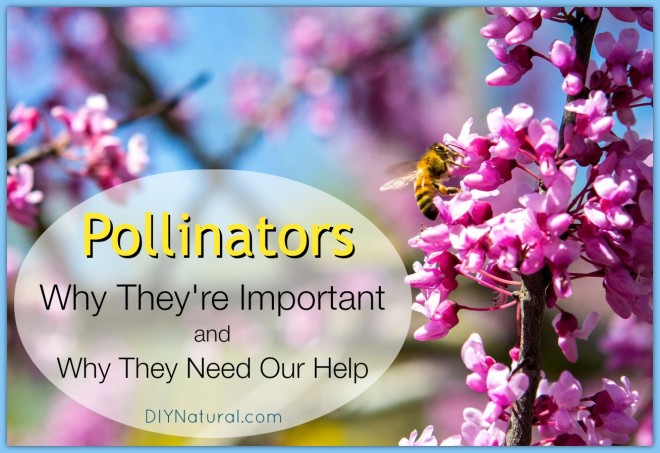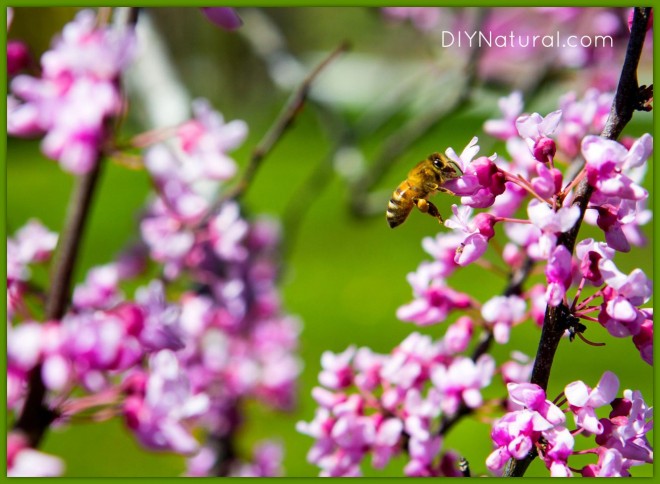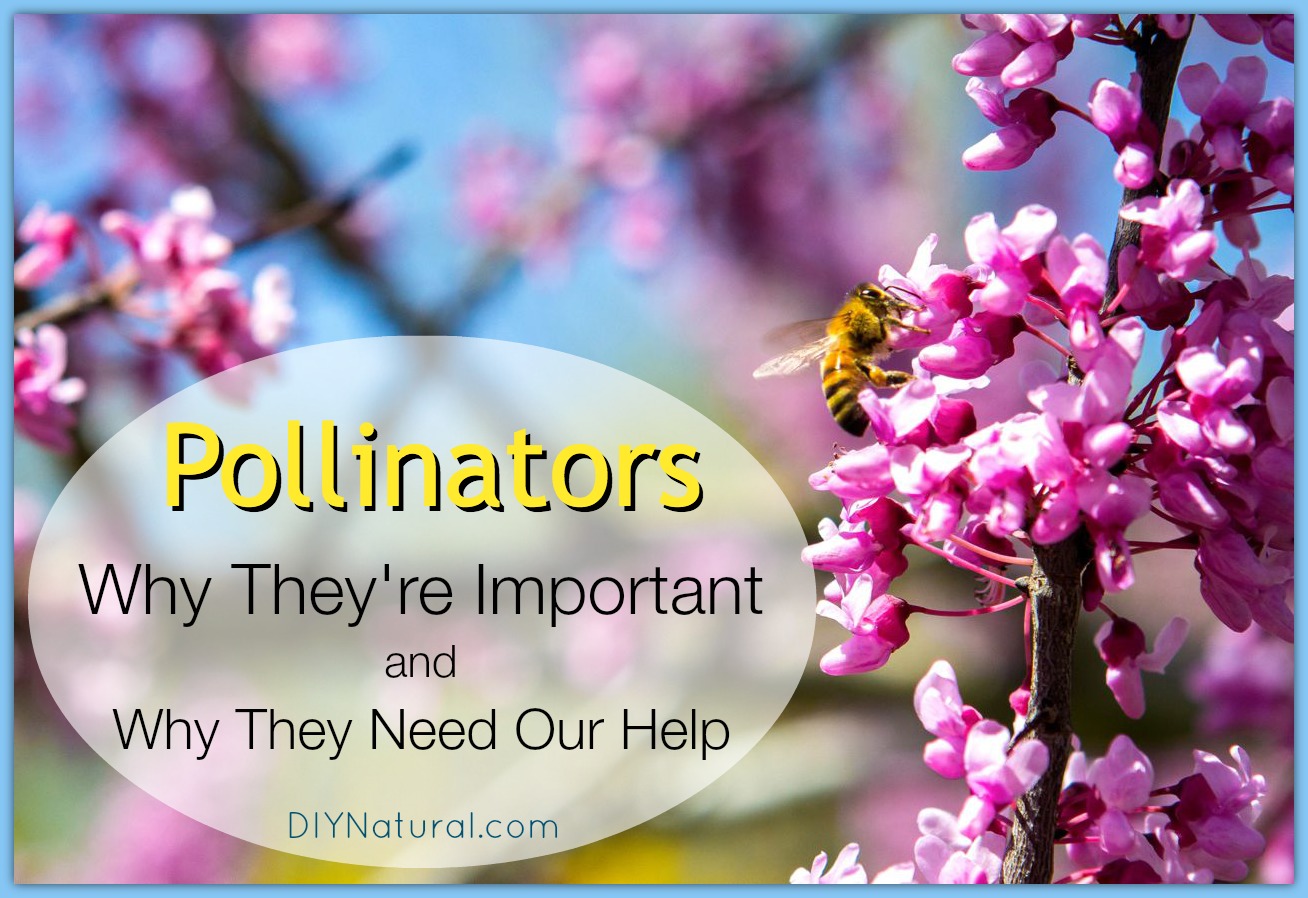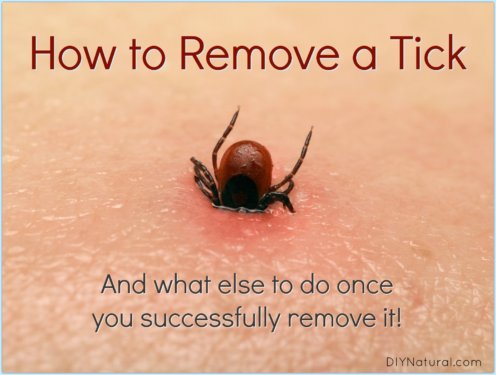
NOTE from Matt & Betsy: Today we’re thrilled to share content with you from one of our brand new writers! Please join us in welcoming Emry Trantham, whose passion and interest in the DIY lifestyle attracted us to her. We hope you enjoy the fabulous articles she’ll be contributing to DIY Natural!
Prior to the last few years, I hardly remember hearing the word “pollinators” outside of a few science lessons in middle school. Now that I’m more immersed in the world of gardening, though, it’s a term with which I’ve become quite familiar.
Between the ever-mysterious Colony Collapse Disorder affecting honeybees and general habitat destruction for most other pollinators, all of us are hearing about pollinators more frequently than ever before. We’re beginning to realize that pollinators are in trouble, and their future is in our hands. We can’t live in a world without pollinators, but the good news is that every one of us can help make this world a better place for them to live.
Why Pollination and Pollinators are Important
Pollination, quite simply, is the way many plants reproduce. Since plants are immobile, they require assistance with their reproduction, and that’s where pollinators come in. They take pollen from one plant to another, thereby making plant reproduction possible.
Pollination isn’t necessary to make flowers grow and bloom, but it is necessary for many plants to grow fruit. If many plants aren’t properly pollinated, they cannot bear fruit or produce new seeds with which to grow new plants. On a small scale, a lack of pollination results in a fruitless tree; on a large scale, it could mean a shortage to our food supply.
Not all the foods we eat require pollinators, but many of them do. Here are just a few of the foods that we wouldn’t be able to enjoy without pollinators:
- Blueberries
- Almonds
- Cranberries
- Tomatoes
- Grapes
- Coconuts
- Avocados
- Broccoli
- Carrots
- Apples
If you try to eat a whole foods diet, you’re probably aghast at the thought of losing those foods. Most of these are on my grocery list every week, and they’re vital to a balanced diet. And, seriously, what would we make our green smoothies with if we didn’t have coconut milk and blueberries?

Types of Pollinators
You probably already know that honeybees are pollinators, but you may not know that they aren’t even native to North America. In fact, they were imported from Europe in the 17th Century. (Source 3) While honeybees are certainly an important part of American agriculture today, they are far from being the only pollinators that we depend on. Other pollinators include:
- Bumblebees
- Mason Bees
- Butterflies
- Moths
- Bats
- Flies
- Beetles
- Hummingbirds
- Wasps
- Mosquitoes (that’s right, mosquitoes)
With a list so diverse, you might be surprised that we are facing a shortage of pollinators. How can so many seemingly unrelated creatures be in trouble at the same time? The answer to that is complex.
Why Pollinators Need Our Help
One of the biggest obstacles that pollinators are facing today is the use (and misuse) of certain pesticides. Pesticides in and of themselves aren’t new; we’ve been using them for generations. Why are they just now affecting the pollinators so negatively? That has to do with the type of pesticides we are using now, many of which are “neonicotinoids.” That’s a long, hard-to-prounounce word used to describe a class of pesticides that were at first considered improvements over older, more toxic pesticides.
When the neonicotinoid class was registered with the Environmental Protection Agency in 1984, the pesticides were lauded for being less toxic to mammals than many of their predecessors. However, we are beginning to see now that they are affecting pollinators in drastic ways. According to the EPA, “…neonicotinic residues can accumulate in pollen and nectar of treated plants and may represent a potential exposure to pollinators. Adverse effects data as well as beekill incidents have also been reported, highlighting the potential direct and/or indirect effects of neonicotinic pesticides” (Source 1).
With the increase of neonicotinoid pesticide usage has come a decrease in healthy pollinators. (If you’re interested in more information about neonicotinoid usage and how it affects pollinators, please visit The Xerces Society.)
While pesticides are part of the reason that pollinator populations are in decline, there are certainly other aggravating factors. Habitat loss is another issue facing our pollinators. Perfectly weedless, well-mowed lawns have taken the place of flowered meadows and woodland borders. Native vegetation is being replaced with non-native landscaping. The human world is ever-expanding, ever-growing, ever-destructing. When we remove food-sources and nesting sites for pollinators, we make it harder for them to thrive. This is especially harmful to migratory species that often travel thousands of miles between their habitats. When food sources are few and far-between, many insects are less likely to make the distance. (Unfortunately for pollinators, they can’t bring their homemade energy bars, trail mix and BPA-free water bottles with them when they travel.)
How We Can Help
I know the future doesn’t look great for pollinators. They’re being slowly weakened and killed off by pesticides, they’re losing their natural habitats, and their numbers are decreasing like never before. And certainly, the gravity of this situation cannot be underestimated.
But there is good news, too. We humans have put the pollinators in this position, and we can and will help get them out of it. An action so seemingly small as planting a pollinator garden can make all the difference for the pollinator population in your backyard, and next week we’ll discuss how to make your home the perfect habitat for pollinators.
(Spoiler alert: there will be flowers and maybe even some rotten logs. But I don’t want to give too much away just yet.)
*******
References & Recommended Reading:
1. Neonicotinoids, from epa.gov
2. Are Neonicotinoids Killing Bees?, found on Xerces.org
3. Honey Bees Not Native to North America, www.agriculture.perdue.edu
4. Disappearing Bees & Pollinators, from Organic Consumers Association
5. Threats to Pollinators, from US Fish & Wildlife Service




Re: bees. Thinking they were in short supply, we were shocked to be invaded by literally 100″s and 100″s of them when they descended upon the large, heavily laden pear tree in our backyard last summer -fall Sept. 2013. We had just moved to this house in July and observed the abundant crop appearing, not having any idea what was ahead. A friend warned that we would be overrun with birds. Not so.Bees and wasps!! I got stung enough times to decide this was no fun having a pear tree. We picked and gave away as much as we could, inviting any and all to help themselves. The bees were too much and drove people away. Bees made their way into the house, our cars…they were everywhere!! They didn’t stop until the frost came. As spring has arrived, we are hoping and praying for a failed pear crop! As far as we are concerned, there is no shortage of bees in Minnesota.
My friend started with 22 hives around 10 years ago. He now has only 8 left because of the mites and what ever is making the honey bees disappear. He will go out to the hives and some just don’t come home. You are so right that we need to worry about this, especially with all the droughts around the earth. This was a great post and I’m looking forward to the next.
Thanks, Thomas! My husband has had some real difficulties keeping up his bee hives in the past few years, too. It’s a horrible feeling to lose a hive.
Can you tell me the brand names of the pesticides that contain the neonicotinoids? My mil was asking and I wasn’t sure. Looking forward to the garden plan to encourage pollinators.
Hi, Beth. This link to the Xerces Society (http://www.xerces.org/neonicotinoids-and-bees/) gives a good list of brand names in the chart at the bottom of the page.
I’m looking forward to the How-To guide also. I’m hoping to plant the right kind of flowers in my area to attract bees and butterflies!
My husband and I just started keeping our own bees a month ago in Spokane, WA! They are amazing creatures. The Bee Keepers associations in the Northwest are strong and very educational for newbies like myself. I highly recommend it to those who are looking to help our pollinators survive. If I can learn to do it – anyone can truly.
This was really informative. Looking forward to the how-to article. I have somewhat of a phobia of bees and wasps. In the past I have doused them in raid. Now that I am growing veggies, I can’t do that since it will end up in my plants. We have learned to coexist. Now that I have plants that need to flourish, I welcome the bees. Although the wasps still freak me out!
I’ve had to make peace with the stinging pollinators, too. I’m okay with honeybees now, but I’m always going to be nervous when I see a hornet or a yellow jacket!